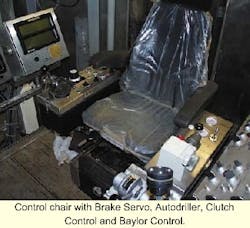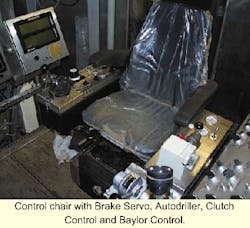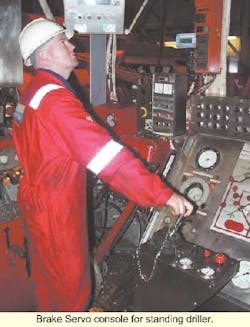DRILLFLOOR DEVELOPMENT: Brake servo and autodriller for drawworks, with band brakes
Along with the complexity in drilling operations, the driller's concentration needs to be focused on an increasing number of surveillance systems. One of the most critical phases in the drilling process is perhaps the operation of the drawworks brake system.
On most drilling rigs, semisubmersibles as well as jackups, the drawworks are equipped with band brakes, operated by the driller through a 5 ft long steel lever. To generate the necessary braking force on the drum, the driller often needs to apply his full body weight onto the brake lever.
In such conditions, the physical strain exposed to the driller often leads to severe shoulder and back fatigue injuries. A short moment of distraction can be enough to cause fatal damage to equipment and also is a potential injury risk to the floor personnel.
This potential risk was recognized early on by drill managers on semisubmersibles as well as by an increasing number of jackup operators. Over the years, Lidan Engineering has gained a solid reputation for upgrading drawworks of the band brake type with a servohydraulic brake control system, which the company claims has improved drillers' working conditions substantially.
Designed to mimic the driller's habitual braking technique, the Lidan DBS brake servo system is an ergonomic aid for the driller to operate the drawworks band brake at a high degree of precision of load versus speed. A small, but rigid control lever, installed either in a pedestal type console, or a console integrated with a control chair, provides the necessary feedback for the driller to continuously "feel" the load.
Coordinated with the auxiliary brake, the driller can control the velocity reduction softly down to a full stop. The lower the pay out velocity, the higher the resolution, which means more sensitivity and precision at creep speed. This feature has been used especially for the company's latest development, the Lidan ADS autodriller system.
Along with the DBS brake servo, the ADS autodriller and the well proven PLC-based Lidan DBC block control system, Lidan now offers a full range of brake control systems for drawworks equipped with band brakes.
Upgrading of older rigs
Today, due partly to the introduction of (cyber base) drill control stations on the newer rigs, upgrading of the driller's working conditions has become a hotter issue. The drawworks manufacturer can offer a servo control system only in combination with a change out to disc brakes. However, this has a price tag of about half a million US dollars, a sum of money that in most cases the owners of older rigs simply cannot accept, claims Lidan Managing Director Thorbjörn Friman.
With the Lidan DBS brake servo alternative, where the band brake remains as an integral part, the price is less than one fifth of that sum. Friman claims that the brake control qualities on the band brake are not less than for the disc brake, apart from the traditional noise during braking, which is lower on disc brakes. He admits, "The installation cost is comparatively negligible. The installation is often performed offshore, during the rig's normal drilling operations and seldom by the rig crew themselves. Only a week is required and the hookup, under surveillance by a Lidan service engineer, is performed within a natural window of 3-5 hours. That includes training the crew."
Autodrilling
"In the past the majority of brake servo systems deliveries were installed on semisubmersibles," Friman continues. "For this type of drilling rig, there is no need for an automatic drilling system, as the control of bit weight is achieved simply by balancing the pressure on the hook compensator." On jackups, there is, for obvious reasons, no hook compensator available. Bit weight and feed-out are controlled the traditional way by manual operation of the steel lever.
Lidan recognized the need for jackups to have a reliable autodriller in combination with a brake servo. Taking advantage of the creep speed braking qualities of the DBB brake servo, the new Autodriller system is designed with rate of penetration (ROP) as the primary parameter.
Automatic feed-out
The automatic drill-line feed-out control is an aid for the driller to maintain a steady ROP. The system mimics manual drilling, however, it releases the driller from continuous concentration on the load indicator, with his hand on the brake lever. After adjusting the feed-out to a desired bit weight, the driller simply needs to check any bit weight fluctuations and to re-adjust the feed-out correspondingly. The feed-out keeps it stable, even in the case of a drilling break, which is indicated as a sudden decrease in weight on bit (WOB) only.
All controls are located at the brake servo console. The system is activated by a switch button. Feed-out speed is adjusted by a control knob at three quarters of a turn. Drum pay-out range in revolution per minutes is adjustable - 0.0-4.5 rpm, which corresponds to 0-250 ft/hr with 12 strings on the traveling block. The system works hydraulically as a closed loop circuit regulator, consisting of the following: brake actuator, brake band, drum, and feedback hydraulic motor.
The system automatically identifies the point where the band brake releases the drum to start pay-out, whereupon an equilibrium rate of braking is immediately established via the feedback motor signal to the brake actuator. The feed-out is steady and even and the speed corresponds to the setting of the feed-out control knob. All safety features, as standard for the brake servo, are integrated into the automatic feed out control system. The fail-safe spring brake becomes activated:
- At loss of servo pressure
- At electric mains failure
- At loss of air pressure
- When the floor limit setting is exceeded (if implemented)
- On manual pushing of the emergency button.
Automatic WOB control
As an option, an automatic WOB control may be integrated as a complementary feature to the ROP control. The feed-out control works well in conjunction with the traditional hook load indicator, while the WOB control requires an electric signal with a high degree of resolution.
The desired bit weight value is selected with a pre-set offset plus and minus value. After adjusting the feed out to conform with the desired bit weight, the WOB setting is activated by a push button, simultaneously as the feed-out knob is to be increased by 5-15%. The bit weight is now controlled automatically within the offset range.
The WOB and feed out control does not relieve the driller of responsibility, but should be viewed as an additional aid for the driller to share his focus with other instruments vital to the drilling process.
Murmanskaya jackup
Lidan recently completed a unique installation on the Russian drilling jackup Murmanskaya. Within a comprehensive upgrading program there are, among other items, a refurbished National 1625 and a driller's cabin with completely new drilling instrumentation.
Lidan delivered a DBS brake servo, an ADS autodriller system, and a driller's chair for the drill cabin. The control chair is equipped with a left console for upper and lower clutch control, eddy current brake controller and break out controllers. The right console includes the brake servo lever, feed out control and WOB setting control.
Initially, the driller's cabin was planned for location on the traditional position, close to the drawworks. However, when the drill crew realized that the brake servo also is a remote brake control, it was decided to move the cabin over to the opposite side of the drill floor, which allows for a superior overview of the drillfloor activities.
"The remote control capabilities are often used, especially when the brake servo is installed on drillships, where the drillers cabin often is located remotely, sometimes even at an upper deck position above the drill floor," Friman concluded.
For more information, contact Thorbjorn Friman, Lidan Engineering. Tel: +46 510 485 570, Fax: +46 510 21018, E-mail@: [email protected].


